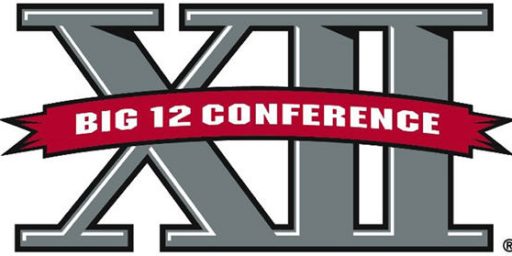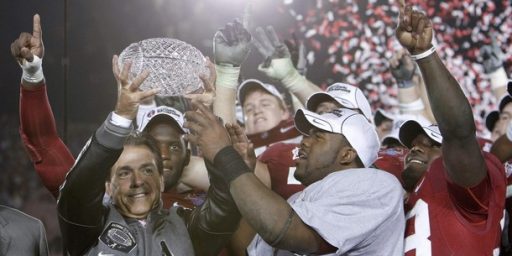College Conference Chaos
Texas and Oklahoma have reopened Pandora's Box.

After a decade-plus of relative calm since the last massive shakeup of the major college sports landscape, all hell appears about to break loose again. Eleven years ago, it appeared that the Big 12 Conference was imploding when Nebraska left for the Big Ten and Colorado left for what became the PAC-12. While both Texas A&M and Missouri would leave to join the Southeastern Conference (SEC) the next year, Texas and Oklahoma were persuaded to stay and some lesser teams joined the Big 12. Aside from some minor moves in the next couple of years, with irrelevant Maryland and Rutgers leaving the Atlantic Coast (ACC) and Big East conferences, respectively, for the bigger payday of the Big Ten, the remaining Power Five conferences remained stable.
This week, though, rumors that Texas and Oklahoma would join the SEC have set off a mad scramble. While details remain to be worked out, it appears that all parties other than Texas A&M have accepted the move as a foregone conclusion.
ESPN‘s David Hale (“Source: Oklahoma Sooners, Texas Longhorns on the verge of making SEC move“):
Texas and Oklahoma could make their move to the SEC official in a matter of weeks, ESPN has confirmed.
The Austin American-Statesman reported Friday that a Big 12 source believed talks between the SEC and the two schools had been ongoing for more than six months, though SEC member Texas A&M had been left out of the discussions. An SEC source told ESPN’s Heather Dinich that it’s inaccurate that A&M was left out of the conversation.
The report also said the move could become official in a matter of weeks. A high-level administrator said his understanding of the situation mirrors that timeline.
[…]
If the schools’ move to the SEC becomes reality, the fallout for the rest of college football would be massive, and the administrator believes the larger impact could significantly damage the sport.
Several ACC athletic directors believed that their league would make a push in the next few years to add both Texas and Oklahoma — along with Notre Dame, which already is a partial ACC member — as it looks to restructure its TV contract, but the suddenness of the Longhorns’ and Sooners’ move to the SEC took them by surprise.
One ACC AD wondered whether this could be the first domino leading to a massive shake-up that would ultimately result in a 32-team superconference. Two other ADs suggested that the best path forward might be for the ACC, Pac-12 and others to work together toward a new media rights package that could help counter the outsized strength a 16-team SEC would command, with one AD also saying he believed there was minimal value in what would remain of the Big 12.
Yahoo’s Pete Thamel (“With OU and Texas nearing Big 12 exit, here’s the biggest questions looming over college athletics“) reports that the conference is in denial:
In conversations with sources around the Big 12, there was a resignation in the past 36 hours that Oklahoma and Texas were gone. The focus has shifted to the unwinding and the amount of money it can wring out of OU and Texas.
“Is this a loss for the Big 12, absolutely?” said a high-ranking official “Is it fatal? Absolutely not. We see doors open, and we’ll run right through those doors. I would think that we go big. We have some opportunity for our teams.”
One source put forth a humorous analogy Thursday night: “It’s like a shopping mall lost their two anchor stores, and the rest of the stores are trying to figure out how to stay open.”
How will the Big 12 stay open? Everything will be on the table. One source indicated it could go as large as 16 schools. Could a Western wing with San Diego State, BYU, Boise State and Colorado State be flanked by additions like Houston, Cincinnati, UCF and USF? Those are huge markets and promising programs. The Texas schools in the league – Texas Tech, Baylor and TCU – are expected to try and undercut Houston, but there aren’t many Group of Five programs that have its combination of local population and fertile recruiting ground.
The good news for the Big 12, in a perverse way, is that none of the eight remaining schools in the conference have the market or the cache to emerge as transformative additions for the ACC, Pac-12 or Big Ten. They’re certainly not in the same universe that Texas and Oklahoma were for the SEC. Those remaining eight schools don’t have to walk on eggshells anymore around the two alphas, and there’s a feeling that the leadership will be bold and aggressive in re-shaping the league. The league’s best asset is still the state of Texas, perhaps the country’s richest football state. Can they find footholds in others?
This is just silly. Because football drives the train (more on that later) the Big 12 is simply toast without Texas and Oklahoma. Aside from Notre Dame, there’s not a team of comparable attractiveness out there. Indeed, the Big 12 strongly considered adding BYU, Cincinnati, and others a couple of years ago and decided the value simply wasn’t there. The television networks aren’t going to pay them like a major conference with only minor schools to showcase. While one could imagine A&M returning out of spite because it joined the SEC to get away from Texas (the university, not the state) it would be financially stupid.
Indeed, wiser heads in Big 12 leadership are reportedly already looking into a merger with the PAC-12, Bruce Feldman and Sam Khan Jr. report for The Athletic (“Sources: Texas and Oklahoma to inform Big 12 of exit next week, with plans to bolt for SEC“):
Reaching out to the Pac-12 about a potential 20-school merger was discussed during Thursday’s Big 12 leadership call. Such a move seems to be a more favorable alternative for the Big 12 than bringing in new members, which might involve raiding the American Athletic Conference, to lift its membership back into double digits.
“Bringing in a Cincinnati and UCF doesn’t bring any eyeballs,” the AD said.
A second league AD said, “There is no combination of Group of 5 members we can add that will garner our same TV deal, but it’s all on the table right now,” then added, “I don’t think (Texas) A&M has been very successful in blocking this.”
I could see this being attractive to the PAC-12 membership, as that conference has struggled under the Playoff structure, failing to land a team into the mix more often than not and having trouble drawing eyeballs with so many of its games in the middle of the night for much of the country. This merger would make the long-forecast outcome of four 16- or 20-team superconferences all but inevitable.
While I understand the financial incentives at play here, I hate it. It’s all driven by football and, while I’m a college football fan, it’s bad for the rest of college sports.
For football, a quasi-professional league of the top 64ish programs makes good sense from a competitive and organizational sense. But it’s crazy to have Rutgers play Nebraska in regular-season baseball or Texas A&M compete against South Carolina in regular-season basketball. There are just too many games a season and they’re often not even on the weekends.
For all sports but football, I would much prefer to go back to the pre-1992 status quo of multiple regional conferences. Before the Big 12, there was a Southwest Conference and a Big 8 that included some of the now-fringe schools and played in a much tighter geographic footprint. It simply makes the logistics of traveling for sports like baseball, swimming, basketball, and others that play way more games than the 12 that football does on fall Saturdays.
I know that this ship has sailed and further consolidation is all but inevitable.






I don’t think the Big-12 is going to be as attractive to PAC-16, as they’re not going to want to be tied to the Texas State government’s use of athletics for political purposes.
e.g. there are PAC-12 schools that have trans-woman athletes, none of whom would be allowed to compete in Texas. You think schools in Oregon, California, and Washington was to be in the news for kicking trans athletes off their teams so they can play second rate schools in Texas?
FTFY
I think the addition of NIL and likely additional compensation policies in the not-too-distant future means that a superconference is inevitable.
@Stormy Dragon: One of the advantages of bringing back the SWC is that it avoids these kinds of issues. I think Kansas basketball and several of the Big 12 football programs have value. But, yeah, there are pitfalls as well.
@Steven L. Taylor: Yes. It’s hard enough to compete against the blue bloods now but the ability of boosters to offer thousands to prospects will eliminate most schools from serious competition.
Some of these kids are going to get set for life, and maybe never play in the NFL. Johnny Manziel is a perfect example He would have made millions his last two years in college, yet was an NFL bust.
College football, as we knew it, is over. And I’m happy to see it.
@EddieInCA: Manziel is a poor example, as he signed an $8.2 million contract that was mostly guaranteed. But he was among the last of that generation before the NFL and NFLPA froze out the rookies and ensured that wouldn’t happen again.
I’ll believe UT going to the SEC when I see Austin formally agree to the SEC revenue sharing arrangement and ban on individual school cable/satellite networks. It’s possible that they have finally learned their lesson. The SWC collapsed because UT demanded preferential treatment on revenue, and the members of the original Big 12 that fled left because UT demanded preferential treatment there as well. Years ago UT looked at trying to wrangle an invitation from the Pac-however-many-it-was, but dropped the idea when the conference told them “Equal shares on TV revenue and the Longhorn Network shuts down” wasn’t negotiable.
@James Joyner:
The point still stands. There are many NFL busts that would have made a fortune if allowed to cash in in college. Additionally, if you can make several million a year in college, why go pro early? Why not go all four years making that money, just in case. Matt Leinart, LenDale White, and Reggie Bush would have made millions in the early 2000’s on that USC team.
At the time of the last Big 12 break up, both Texas and OU looked into leaving and the rest were scrambling to find new homes. PAC-choose a number said noto Baylor because it is a religious school and no to Ok St because their academics suck. Neither of those have changed. But maybe the threat of a monster SEC will scare them into changing their minds?
Honestly, I don’t see any of the remaining schools as being attractive for other major conferences. I can see adding one Texas school just to have a Texas audience and maybe KU for basketball (but what a drag on FB) and the KC market.
I don’t understand all this talk about money. After all, the NCAA has long maintained that the reason people love college sports is because it’s all about amateurism and that any hint that anyone involved might be driven by a desire for money would simply end the game forever.
@BugManDan: Honestly, a lot of the remaining schools are good adds to the PAC-12. Kansas State and Iowa State are pretty good at football these day and Baylor, TCU, Texas Tech and others have their moments.
@wr: It’s been a long time since they’ve claimed that money wasn’t an issue. The argument around “amateurism” has long been—indeed, started as—an argument about the nature of the competition. The Ivy League formed because so many schools, including their own members, were hiring ringers to win even in the late 1800s. Ditto the NCAA.
Name, image, and likeness is something schools will adapt to but it will further the chasm between the Big Time programs and Everyone else. Maybe that’s a good thing. But it will definitely change the nature of the competition when boosters can openly bid on high school players to entice them to their college program.
@wr:
And you believed that b#!!$%!t? REALLY?
@Just nutha ignint cracker: I had a friend tell me, 25ish years ago, that he liked college football over the NFL because it was “purer”–I managed not to guffaw. He was a Florida fan.
@Just nutha ignint cracker:
Irony is a thing.
@Steven L. Taylor:
I love hockey. Especially high level college and international. NHL hockey I find aesthetically unpleasant and boring.
High level college hockey is big money but teeny tiny compared to football and basketball. Comparably far less money sloshing around used nefariously. I like that.
I went to a D3 school. Even D3 hockey is good hockey. In Minnesota anyway.
@James Joyner:
That adjustment was made in 2011, a few years before Haslem listened to a homeless dude and drafted Manziel at #22.
As a comparison, six years later, Minnesota chose badass receiver Justin Jefferson at #22. His contract guarantees him $13.1m.
—
The rookie scale makes sense–I don’t see it as freezing rookies out.
-2010 #1 overall Sam Bradford signed a six-year contract with $50m guaranteed (~$8.33m/year).
-2011 #1 overall Cam Newton signed a four-year contract with $22m guaranteed ($5.5m/year)
In September of 2010, some dude named Tom Brady signed a four-year contract extension that guaranteed $48.5m over four years ($12.125m/year)
One more: Bradford’s second year, the Rams actual cash spent on his contract was the highest of any QB, a few 100k more than P. Manning.
It was way out of whack.
I should care why?
What exactly do college athletic conferences do? What is their purpose? Any idiot independent could arrange an in-state or state boundary rivalry game.
What do conferences do in a practical sense?
@de stijl:
The major conferences mostly bundle a bunch of college football and college basketball games together, and sell it for hundreds of million of dollars per year to the networks, in order to cover the costs of semi-pro teams in those sports and some number of minor sports.
Dr. Joyner thinks in terms of those semi-pro teams. I claim that one of the reasons there will be no Midwestern teams added to the Pac-12 is the cultural difference. Consider: Stanford, 123 NCAA titles in 20 sports; UCLA, 118 titles in 20 sports; USC, 107 in 17 sports. Cal comes in at 10th, with 38 titles in 10 sports. One way to look at it is the Pac-12 is about building the US Olympic team. (Note how many people are looking at the newer sports in the Summer Olympics and announcing “Welcome to the California Games.”) When Stanford announced they were going to cut a bunch of minor sports in order to focus on football and basketball, the students almost rioted. The administration backed down.
@Michael Cain: The PAC-10 was desperately seeking to expand to 16 teams by adding Texas, Texas A&M, Texas Tech, Oklahoma, Oklahoma State, and Colorado just eleven years ago. Ultimately, the Big 12 staved them off and they added only Colorado and Utah—either obvious fits. But Texas A&M soon moved to the SEC and now it appears Texas and Oklahoma are about to join them. Those are easily the three most desirable of the original group.
That said, many SEC schools, including Alabama, are competitive in the Olympic sports. Alabama alone has won multiple national championships in gymnastics, swimming and track and field.
@James Joyner:
Alabama is now a Midwestern state available to the Pac-12 if the Big-12 breaks up? I just don’t see the Pac-12 trying to stretch itself this time around into a third time zone for four schools that don’t match up well culturally and aren’t going to make them any more competitive in football anyway.
@Michael Cain: Ah. I missed the “Midwestern” part of the original comment. Not a lot of Midwest in the Big 12, really–just the Kansas schools and Iowa State.
Kansas is the big prize there. Solid academics. Sportswise, it’s a basketball school with atrocious football. But it’s been pretty competitive in track and field as well. They’ve reportedly made overtures to the Big Ten, which is the more obvious fit for the Midwestern schools.
Good to see that the major issue of the day in our institutions of higher learning is how to best package sports entertainment for TV revenue and Monday morning alumni bragging rights.